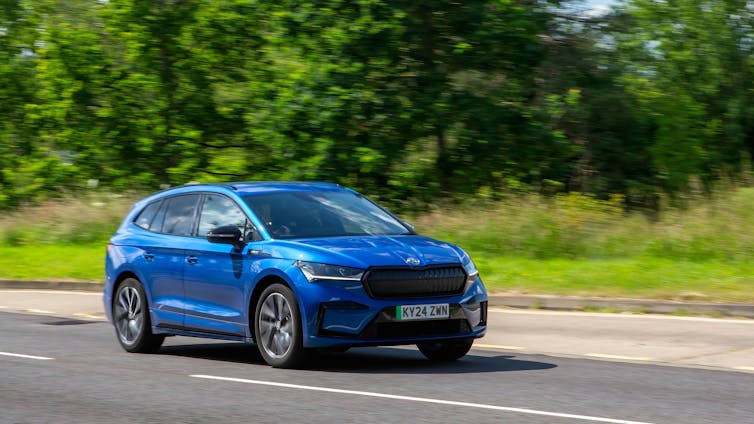Exposure to air pollution is associated with around seven million premature deaths per year across the world. When we think of urban air pollution, diesel exhaust emissions are often portrayed as a key culprit – rightly so, given previous research findings. However, our latest research shows that dust from brake pads could be more harmful to our lungs.
Dust produced by wear of the road, tyres, and brakes, known as “non-exhaust emissions”, are now the major type of emissions from road transport, surpassing exhaust emissions across many European countries. Of these, brake dust is often the main contributor, but it’s not yet subject to regulation. There is much less known about the potential health effects of brake dust compared to diesel exhaust dust.
We grew cells in the lab to mimic the lining of the lung, and exposed these cells to both brake dust and diesel exhaust dust. Brake dust proved significantly more harmful to these cells across different measures that are linked to lung diseases such as cancer and asthma. Interestingly, we found that removing copper from the brake dust reduced these effects.
Despite this, current vehicle regulations in the UK only target exhaust emissions. Our findings suggest there is an urgent need to consider regulation of non-exhaust emissions as well. Reformulating brake pads might be one way to reduce the potential health burden imposed by these emissions.
Brake pads previously contained asbestos fibres to deal with overheating. However, asbestos was banned in the UK in 1999 because of links to lung disease. This resulted in the motor industry designing new brake pad linings, including non-asbestos organic (NAO) pads commonly used in vehicles today.
We compared the harmfulness of dust from the wear of different pad types. Ironically, we found that dust from the NAO pads, designed to replace asbestos-containing pads, was the most toxic to lung cells compared not only to dust from other pad types, but also to diesel exhaust dust. Some of the effects on our exposed cells relate to diseases such as lung cancer, lung fibrosis (lung scarring), asthma, and chronic obstructive pulmonary disease.
Photology1971/Shutterstock
Previous research has shown that metals in air pollution particles can have toxic effects. We measured the metal content in the different types of brake dust and diesel exhaust dust. AI techniques identified high copper content as the defining characteristic of brake dust from NAO pads.
We also found that this copper could get inside exposed lung cells. Most interestingly, when we treated this brake dust with a chemical to neutralise copper, its toxic effects were diminished. This suggests that copper is causing at least some of the harmful properties of this dust.
Almost half of all copper in the air we breathe comes from brake and tyre wear. Various studies conducted by other research groups have found that exposure to high concentrations of copper is associated with impaired lung function, and overall risk of death.
EVs aren’t perfect
There is a huge body of evidence showing that airborne dusts are damaging to our health. Unfortunately, while the switch to electric vehicles (EVs) will eliminate exhaust emissions, which include toxic gases as well as dust, it will not eliminate road, tyre and brake dust. Studies indicate that, because they tend to be heavier, electric vehicles can generate more non-exhaust dust than petrol or diesel vehicles – the zero-emission label is clearly not accurate.

Sue Thatcher/Shutterstock
Some EVs are fitted with regenerative braking systems that allow the engine to act as a generator, slowing the car. However, EVs are still fitted with friction braking systems, which help bring the car to a full stop, so they still generate brake dust.
The upcoming Euro 7 emissions standards that will be introduced in November 2026 will place limits on brake dust emissions which may spur innovation to develop new brake materials or dust-trapping mechanisms. They may also place extra focus on traffic calming and road design, to minimise stop-start and aggressive driving styles – both of which increase brake dust emissions.
New brake pad formulations might reduce the total level of dust emissions or might be designed to exclude toxic components similarly to how asbestos was eliminated previously. Notably, in the US, both California and Washington have passed legislation to reduce copper content within brake pads, although this was primarily in response to concerns about the runoff of copper from brake dust into waterways, affecting aquatic life.
Non-exhaust emissions are all around us, making up around 60% of all vehicle-derived pollution particles in the UK. It is important for us to recognise that there is no air pollutant for which there is an established safe exposure level.
As we make the shift to electric cars, science and regulation must approach these emissions as seriously as those from the exhaust pipe.

Don’t have time to read about climate change as much as you’d like?
Get a weekly roundup in your inbox instead. Every Wednesday, The Conversation’s environment editor writes Imagine, a short email that goes a little deeper into just one climate issue. Join the 40,000+ readers who’ve subscribed so far.

The post “Car brake dust can be more harmful than diesel exhaust – new study” by James Parkin, Research Fellow, Air Pollution, University of Southampton was published on 02/14/2025 by theconversation.com




































Leave a Reply